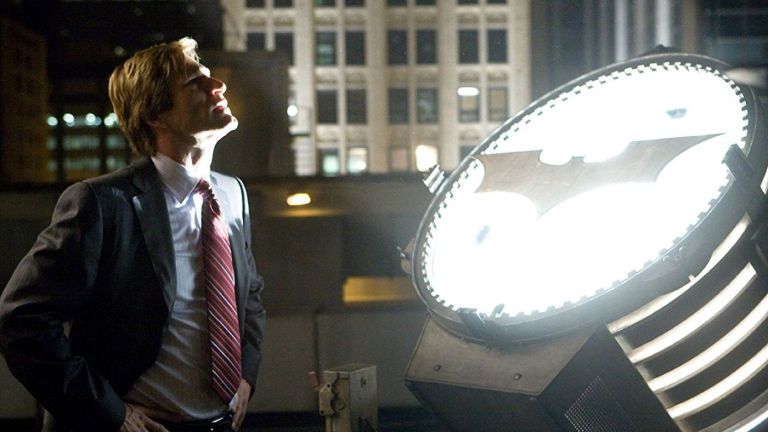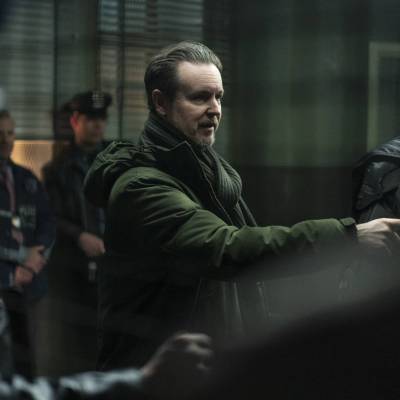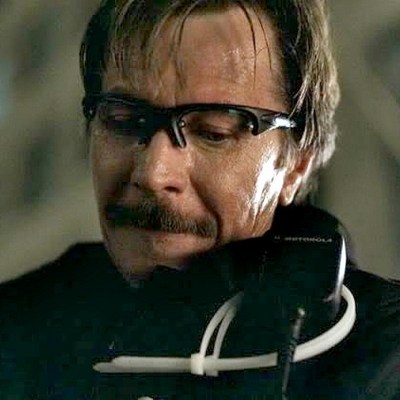Harvey Dent Is the Unsung Hero of The Dark Knight
Batman might be the titular character of The Dark Knight, but the fall of Harvey Dent into Two-Face is the film’s backbone.

“You either die a hero or you live long enough to see yourself become the villain.” It’s a sentiment and phrase which has taken on a life of its own in the 14 years since Aaron Eckhart’s Harvey Dent said it in The Dark Knight. Written in its time by the brothers Jonathan and Christopher Nolan as a way to succinctly (and heavy-handedly) foreshadow Dent’s downfall, these words have entered the public consciousness, often quoted by people who do not realize they’re borrowing a line from a superhero movie.
That’s because despite being one of three central pillars that make The Dark Knight still the most gripping of superhero epics, Dent’s descent is often overshadowed when juxtaposed with Christian Bale’s tortured and guttural Batman and Heath Ledger’s rockstar Joker. Even so, it is Harvey Dent’s tragedy and the sympathetic fury of Eckhart’s performance which drive The Dark Knight toward the compelling masterpiece it became. Ledger’s Joker is an unforgettable personification of evil, but how various characters react to staring into his abyss is what makes the movie a classic—particularly the one who withered before that gaze.
A Legitimate Ray of Light
Nolan has made no secret that The Dark Knight’s structure is loosely modeled off another seminal summer blockbuster: Steven Spielberg’s Jaws (1975). Like that movie, the civic leaders of a community find their institutions and moral stamina tested to their breaking points when a proverbial monster who cannot be reasoned with enters their jurisdiction and starts killing at random. In this analogy, Ledger’s nightmarish creation is obviously the shark. But among the three main characters who choose to act—Batman (Bale), the one good cop Jim Gordon (Gary Oldman), and hotshot district attorney Harvey Dent (Eckhart)—Batman is not Jaws’ main character; the vigilante can never be the public face of authority and morality.
If one entertained that analogy to its inevitable conclusion, Bale’s Batman would be Jaws’ Quint (Robert Shaw), an outsider whose eccentric methods are barely tolerated by the community until they become vital in matters of life and death. The “hero,” the man Gotham City believes must save them… is Dent. Never screenwriters to favor subtlety, the Nolan brothers make that point explicit in a scene where Batman finds Harvey breaking the law and playing the Dark Knight’s kind of game as he threatens a Joker goon.
“You’re the symbol of hope I could never be,” Batman tells Dent. “Your stand against organized crime is the first legitimate ray of light in Gotham in decades. If anyone saw this, everything would be undone.” The line speaks to the shadowy duality between Batman and Dent, one the so-called “White Knight” in shining armor that Gotham needs, and the other its dark counterpart which the city truly deserves. In Nolan’s more grounded understanding of this mythology, Bruce Wayne became Batman to make the rise of a man like Dent possible.
The strength of the movie then is that like Bruce Wayne and so many other characters in the film, the picture believes in Harvey Dent. A more cynical or slapdash approach to the material would depict Dent as a heel; the golden boy who really was two-faced even before half of his face got burned off. In the film, he’s even dating Bruce’s unrequited love, Rachel Dawes (Maggie Gyllenhaal). It’d be so easy to make him the villain through and through.
Yet Eckhart’s doomed Harvey is not a villain. Not when he vows on campaign ads to clean up Gotham City’s streets at the beginning of the picture, nor is he one at the end, even when he has a gun pointed at a little boy’s head. In the literal classic sense of ancient Greek dramaturgy, Dent is the tragic hero of the story.
A Tragic Knight
When we meet Eckhart’s Harvey, he has one foot in the heightened world of a comic book movie, hardly raising an eyebrow when during a mobster trial a hostile witness pulls a gun on him. And yet, the other is grounded directly into what was our own in 2008. Within the film’s potent allegorical setting during the last days of the Bush Years, and the height of an endless “War on Terror” which saw greater and greater concessions to “security,” here was a good man trying to keep his city safe from supervillains explicitly and implicitly coded to be “terrorists.” And at least at first, his bending the rules by partnering with the Batman works.
More important to engendering audience sympathy, however, The Dark Knight also reveals Harvey is the Batman’s biggest public booster, defending the film’s titular character from cynics even named Bruce Wayne. It’s in that scene where Bruce and Harvey meet in their “off-hours” where Dent utters the famed “You either die a hero” line. Later in the movie when public opinion turns on the Batman because the Joker threatens to kill more people unless the Dark Knight publicly unmasks himself, Harvey literally protects Bruce from the howls of the mob. During a press conference where Bruce is preparing to turn himself in, Harvey first tries to reason with a skeptical press that “the dawn is coming” and then, when that fails, claims he is the Batman.
He bends the rules again to put his life literally on the line, taking the proverbial bullet for Batman and gambling that by claiming he is the vigilante, the Joker will try to murder him—thereby setting a trap for the actual Batman to instead ensnare the clown.
“I trusted him to do the right thing,” Harvey tells reporters later, after the Joker has seemingly been apprehended. “[Which is] saving my ass.”
As an action movie, this level of camaraderie between Dent and the Batman, as well as Jim Gordon, is usually the centerpiece in Hollywood storytelling. And in a movie that flirts so openly with the iconography of post-9/11 imagery, it added a particularly sympathetic edge for 2008 audiences who could perhaps see themselves in everyman characters like Dent and Gordon: the other two prongs of a central triumvirate who think despite their current moment of darkness they could make the world a better, safer place.
It is thus Harvey’s fall from grace that becomes the backbone of the movie.
In antiquity, the tragic hero typically was a character of good intention and moral virtue who succumbed not only to external forces but his own human weaknesses. In Poetics, Aristotle noted that the tragic hero falls “not through vice or depravity but by some error of judgment.” So it is in The Dark Knight that Harvey succumbs to his demons not (only) because of his own fallibilities, but his trust in the system, including Batman, “to save his ass.” Even as they all continue to break the rules those institutions have in place.
In comics and animation, many of the most popular interpretations of Dent involve a character who was already hiding a literal split personality disorder (as seen in Batman: The Animated Series) or a dark side that has them already being fingered as a potential murderer, even if that turns out to be a red herring (a la Batman: The Long Halloween on the page). In The Dark Knight, Harvey really is “the best of us,” as Bruce painfully confesses at the end of the film when he sees Dent holding a gun over a child’s head.
Harvey was a character who was created in a zeitgeist defined by fear and paranoia, and he represented the desire for goodness and hope to turn the page on the dark moment. And then the Joker, a walking metaphor for random acts of violence and depravity in The Dark Knight, targeted him for his beliefs and tore him down. Dent’s fatal flaw is his belief in the system, in the hope that things can be better, even as he increasingly compromises himself to do so. He’s punished severely.
Two-Face Is Batman’s Real Test
As good as Ledger is as the Joker, Eckhart’s self-righteous fury and horror at realizing that he and his fiancée are about to die when he wakes up tied to a barrel of oil drums with a timer on them is searing. He knows that at least one of them is about to die a gruesome death, and the betting odds are going to be it’s him. As it turns out, he’s only half-right. Due to the Joker’s manipulations, Batman thinks he is going to save Rachel when he instead finds Harvey sprawled out on the ground, still tied to the chair and now with half his face drenched in gasoline.
Bruce tries to get Harvey out before the bomb goes off, but the drenched half of Dent’s face (and his soul) are entirely enveloped by the flames.
Every comic book reader knew that Harvey’s scarring was coming, yet I suspect most still winced when the fire came in that first viewing. And when presented alongside the brutally unsentimental death of Rachel—who is taken by a terrorist’s explosion mid-sentence—and then that heavy 9/11 imagery returning as Batman stands in the rubble of Rachel’s tomb surrounded by firefighters, it all hit particularly hard in 2008. I can still recall friends and audience members who didn’t live or breathe comics gasping at the sight of Dent’s face half draped in bandages… or later when he reluctantly shoots the Batman in cold blood during the climax of the movie.
Indeed, the big twist of The Dark Knight’s finale is that the real finale isn’t about whether Batman can stop the Joker—it’s about whether he can save Harvey. And the answer is resoundingly more despairing.
In the years since the movie’s release, there’s been an argument that Harvey’s transformation into Two-Face should’ve been saved for Nolan’s third movie. That’s how the basic story’s co-writer, David Goyer, originally pitched it. That would’ve missed the point. Harvey’s character arc is not some kind of post-credit teaser for the next product. His journey into darkness is the bitter heart of the movie at hand.
Batman might be the main character, and he does have an arc in his own right about accepting his destiny and his limits as “the Dark Knight.” But more than either of Nolan’s other two Batman films, The Dark Knight is really an ensemble. It’s as much about Gordon’s reluctant need to tolerate moral flexibility to work within the system, both by coordinating with a vigilante as well as cops he knows could be corrupt; and it’s about Dent who has the biggest character arc when the tab for their sins comes due and he’s left with the check.
The resolution has to be about the price these three paid to do the right thing. It has to be about Two-Face. Which is, again, why Harvey’s story is not about the birth of a supervillain, but the death of an incredibly flawed hero. “You think I want to escape from this?” Harvey says at the end when he realizes Gordon has brought cops to their rendezvous—just like the cops who fed Harvey and Rachel to the mob. “There is no escape from this!”
Obviously, what Harvey does is reprehensible and unforgivable, but like so many leaders who thought they were making the world a safer, better place, his good intentions have led to him becoming a villain doing truly heinous things, even as he cries about what’s “fair.”
In his own twisted way, Eckhart’s Harvey doesn’t want to wear the villain hat even at the end. He’s lost all bearing in a mad world, so he now plays a mad game where he lets a coin flip decide who lives and who dies. His former friends even lean into this by suggesting he should turn the gun, and coin, on all three of them—not Gordon’s son. Harvey does that, hence shooting the Batman, and then aiming the gun at his own head, as if attempting to give Gordon’s family one last chance at salvation.
The way Nolan films this moment is entirely divorced from typical superhero movie bells and whistles, and even his own IMAX blockbuster iconography from earlier in the picture. This sequence is told in tight, extreme close-ups which stare into the face of characters who’ve long forgotten the trappings of hero and villain, even if one of them is wearing a cape. It’s all shades of gray as Eckhart stares blankly at the possible dead body of a man he once idolized, and Hans Zimmer’s score rises with each crack in Oldman’s voice.
In the end, Batman of course saves the day. He bum rushes Dent before we ever learn if Harvey’s coin picked life or death for Gordon’s son, and in this desperation they both go over a ledge, the White Knight and his mirror opposite in matching holes at the bottom of a long fall.
One interesting aspect of The Dark Knight that seems rarely addressed is that Batman does technically break his one rule of never killing. He won’t kill the Joker no matter how much the Clown Prince goads him to do so, perhaps not least of all because he knows it would give the terrorist a philosophical victory over Batman’s sense of moral superiority… and yet he does kill Harvey Dent. Of course in reality, it would be entirely justified; a last ditch effort to save a child from being murdered by a maniac.
But for all of Batman’s absolutism when facing down the Joker, he ultimately does succumb to the complexities of a world that is not binary. Perhaps it’s that betrayal of himself, as well as the guilt he feels over Harvey, that causes him to turn Dent’s scarred face over to his good side in death, choosing to falsely remember the hero instead of the villain.
Gordon says “we bet it all on Harvey,” but Harvey bet it all on them too. And in an ending where none of them can say they really won, even if the Joker is defeated, Batman takes some form of responsibility for this senseless carnage by framing Two-Face’s crimes as his own.
Batman might be the hero the movie needs, but Dent is its broken soul.


